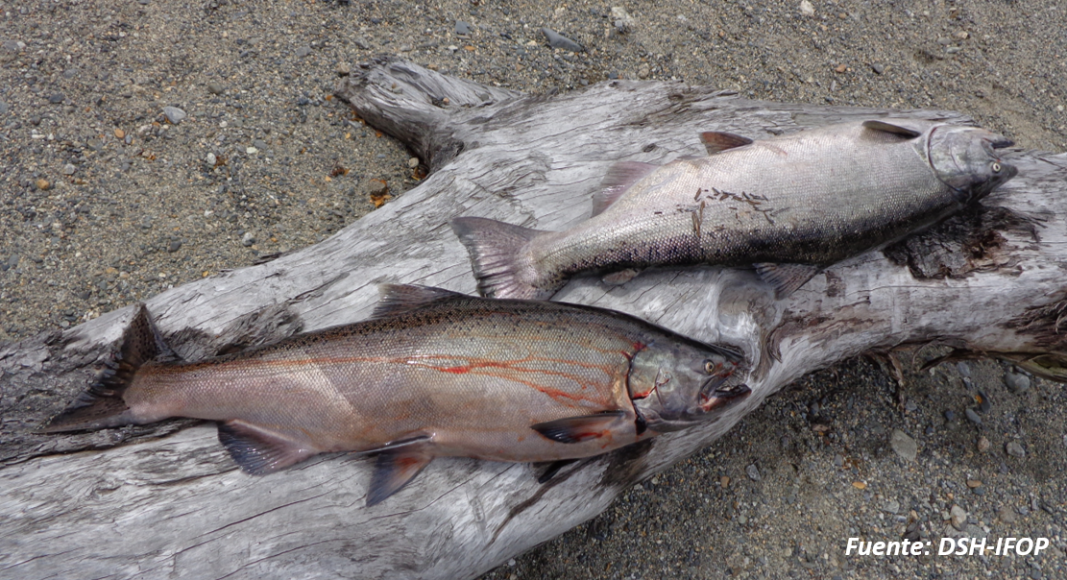IFOP researchers attend National Aquaculture Congress
September 19th, 2018Between September 11th and 14th , VII National Aquaculture Congress will be held in Arica, this activity brings together national and foreign experts dedicated to aquaculture research, organized by Arturo Prat University, through its Natural and Renewable Resources Faculty., has as its motto: “For Aquaculture in Arid Zones Sustainability ” http://www.acuiarica.cl/
A team of IFOP professionals conformed by; Carlos Muñoz Torres; Sandra Saavedra Muñoz; Cristina Stuardo Stuart, Alfredo Astorga Vera, Cristian Ruiz Soto, Valentina Besoain Meneses, Carolina Sotomayor Contreras, Francisco Cárcamo Vargas atended this congress.
IFOP presentations Summaries
Read moreCarlos Muñoz: Progress in native silverside cultivation. Alternative resource for aquaculture and repopulation activities
Within “Repopulation of the Native Pejerrey in Mataquito river” framework research developed by the Institute, between 2010 and 2015, the objective was to develop repopulation actions with pejerrey B. microlepidotus in Mataquito river. This involved activities such as capturing and transferring individuals to form a breeding stock, maintenance and acclimatization in a controlled environment, obtaining eggs and growing larval stages, as well as establishing a methodology for planting larvae for repopulation in said river.
Cultivation of native silverside advances and aspects related to larval survival and improvements introduction to optimize larval and juvenile production that allow to explore repopulating possibilities with juveniles and scaling crop on a commercial level are discussed and described ( aquaculture diversification).
Sandra Saavedra “Chicorea de mar: Experience of Small Scale Aquaculture (APE) in Chile”.
Algae exploitation from natural grasslands has exceeded recommended limits, therefore, many populations are subject to overexploitation and depletion. To improve this situation, it is strategic to transfer studied cultivation methods to the Artisanal Fishermen Organization (OPAs). Chicorea is an algae of commercial interest due to its potential as a human food. The horizontal vegetative culture of Chicorea de Mar was implemented during 90 days, in two localities of the Los Lagos region and the biomass (g m ̄¹) produced in this period of time was quantified. These results are compared with other experiences developed in the country. Cultivation methods, environmental and bio-economic aspects associated with the development of this type of initiatives are discussed.
Cristián Ruiz will present CHONOS web, www.ifop.cl/chonos,
It is an oceanographic numerical models information system, which seeks to provide environmental information in a timely, easy and fast way for fjords and channels in southern Chile. The portal has 3 operational tools to date, one of which is the oceanographic forecasts of the MOSA-ROMS model, which allows us to know a future of 3 days ocean conditions r (currents, salinity, temperature and sea level). We also have Parti-MOSA, which is a complement to the previous one, which allows to simulate passive particles trajectory, very useful for spills contingencies, pathogens dispersion, objects drift, etc. Finally we find CLIC, it is a tool that quantitatively allows to know connectivity degree between different water plots for different environmental scenarios, a very useful tool for marine territory planning and management .
Biogeochemical model in Chiloé inland sea: implementation and perspectives.
Valentina Besoain, Osvaldo Artal, Elias Pinilla, Héctor H. Sepúlveda (UDEC)
In order to reproduce large-scale general conditions of Chiloé inland sea, a biogeochemical model coupled with the hydrodynamic model ROMS-AGRIF was implemented.
The implemented biogeochemical model is a simple type of NPZD (nitrate-phytoplankton-zooplankton-detritus), which uses data obtained from global oceanographic atlas (WOA) as border and initial conditions and COADS as atmospheric conditions. The monthly averages of the biological model variables were compared with in-situ observations, which presented a good representation of main aspects of temporal variability of the area with less influence of fresh water. These results are a first approximation for the understanding of biogeochemical cycles dynamics and that can be used for future implementation of more complex models and more adequate monitoring systems.
Effects of light intensity on Gracilaria chilensis and Rhizoclonium sp interaction when cultivated in different proportions
Carolina Sotomayor, Johana Ojeda, Pablo Leal
Epiphyticism may have negative consequences in macroalgae aquaculture. Macroscopic epiphytes can negatively affect the basophilic species through light intensity reduction with a consequent reduction of photosynthetic activity, preventing gases and nutrients exchange with seawater, and increasing breakage of the thallus risk. In Chile, filamentous macroalga Rhizoclonium sp. (Chlorophyta) is one of the most common epiphytes found on crops of Gracilaria chilensis, causing strong declines in biomass production which has serious consequences on coastal resources and socioeconomic impacts. That is why this research study objective was to determine light intensity effect (90 and 180 μmol photon m-2 s-1) on interaction between G. chilensis and Rhizoclonium sp. co-cultivated in different proportions through measurements of growth rates and photosynthetic efficiency. In summary, Rhizoclonium sp. It showed higher growth and photosynthetic efficiency, but this did not affect G. chilensis, independent of the initial crop biomass. In addition, our results indicate that light intensity does not affect the interaction between G. chilensis and Rhizoclonium sp., Suggesting that other factors (e.g., nutrients, temperature) could be more important to explain what is observed in field crops.
Aquaculture and marine repopulation in Chile. Identification of research gaps and implementation challenges under an ecosystemic approach
Francisco Cárcamo, Luis Figueroa-Fábrega, Luis Henríquez
Considering the importance for Chile of benthic fisheries and potential supply of seeds from aquaculture, it will be relevant to analyze reforestation impact actions in the restoration or improvement of the productivity of natural populations. In this way, objectives of this research study were, first, to review current state of repopulation initiatives in Chile, and second, to identify research gaps and implementation challenges considering recommendations from an ecosystem approach. Some cases are detailed to best exemplify identified gaps and challenges. Based on main results and patterns found in this analysis, and considering current normative, regulatory and technical framework, a conceptual model to implement a national reforestation program under an ecosystem approach is proposed, and its hypothetical implications are discussed.
